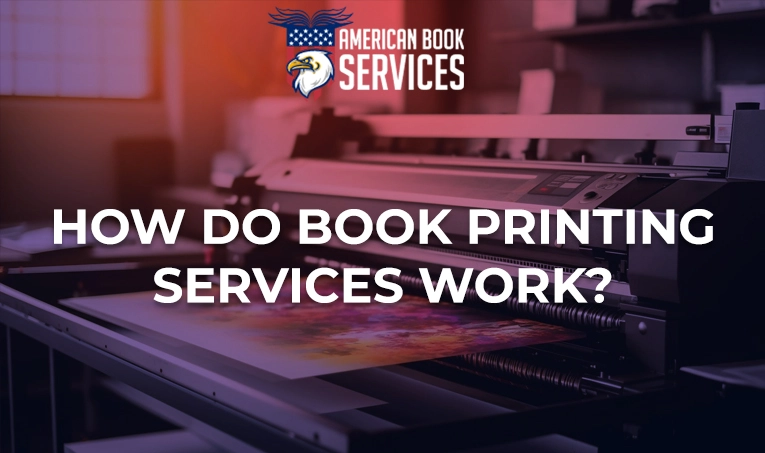How Do Book Printing Services Work?

Introduction
For authors and publishers, book printing services are essential for turning manuscripts into physical books. With the rise of digital platforms, book printing services online have become more accessible and efficient. This guide will explore how these services work and how to choose the best book printing services for your needs.
Understanding Book Printing Services
Book printing services offer various options for authors to print their books. These services range from traditional offset printing to modern print-on-demand (POD) solutions. Here’s a breakdown of how these services work:
Types of Book Printing Services
Print-on-Demand (POD)
Print Only What You Need: POD services print books as orders come in, eliminating the need for large upfront investments and reducing inventory costs.
Advantages:
- No need for large print runs.
- Lower initial costs.
- Ideal for self-published authors or small publishers.
Disadvantages:
- Higher per-unit cost compared to bulk printing.
- Limited customization options.
How It Works:
- Upload your manuscript and cover design to the POD platform.
- Set your book specifications (size, paper type, binding).
- When a customer orders your book, it is printed and shipped directly to them.
Offset Printing
Bulk Printing: Offset printing is suitable for large print runs, offering lower per-unit costs but requiring a significant upfront investment.
Advantages:
- Lower cost per unit for large quantities.
- High-quality printing and more customization options.
Disadvantages:
- Higher upfront costs.
- Need for storage space for inventory.
How It Works:
- Submit your manuscript and cover design to the printing service.
- Approve a proof copy to ensure quality.
- The service prints the entire print run and ships it to you or your distributor.
Choosing the Best Book Printing Services
When selecting the best book printing services online, consider the following factors:
Quality and Customization
Print Quality: Look for services that offer high-resolution printing and durable binding options. Request samples if possible to assess the quality.
Customization Options: Ensure the service offers the formats, paper types, and finishes you need. Custom options like hardcover, dust jackets, and special paper can enhance your book’s appeal.
Pricing and Costs
Transparency: Choose services with clear pricing structures. Consider all costs, including setup fees, printing costs, shipping, and any additional customization fees.
Discounts for Bulk Orders: If you plan to print in large quantities, look for services offering discounts for bulk orders.
Turnaround Time
Production Time: Depending on your needs, choose a service that can meet your deadlines. POD services usually have faster turnaround times compared to offset printing.
Shipping Time: Factor in shipping times, especially if you are printing books for an event or a release date.
Customer Service and Support
Responsive Support: Choose a service with reliable customer support to assist you through the printing process, answer questions, and resolve issues promptly.
Reviews and Testimonials: Check reviews and testimonials from other authors to gauge the service’s reliability and quality.
Steps to Print Your Book Online
Prepare Your Manuscript
Formatting: Ensure your manuscript is properly formatted according to the printing service’s guidelines. This includes setting margins, fonts, and page numbers.
Proofreading: Thoroughly proofread your manuscript to avoid errors. Consider professional editing services for a polished final product.
Design Your Cover
Professional Design: A professionally designed cover can significantly impact your book’s success. Use graphic design tools or hire a designer to create an eye-catching cover.
Check Specifications: Follow the printing service’s cover design specifications, including dimensions, bleed areas, and resolution requirements.
Choose Your Printing Options
Book Size and Binding: Select the book size and binding type (e.g., paperback, hardcover, spiral-bound) that best suits your needs.
Paper Type and Finish: Choose the type of paper (e.g., matte, glossy) and any special finishes (e.g., UV coating) for your book’s cover.
Upload and Review
File Upload: Upload your manuscript and cover files to the printing service’s platform. Ensure they meet all technical requirements.
Proof Copy: Order a proof copy to review the final product. Check for any printing errors or formatting issues.
Place Your Order
Order Quantity: Decide on the number of copies you want to print. For POD, you can print as needed. For offset printing, determine your initial print run based on demand.
Payment and Shipping: Complete the payment process and provide shipping details. Monitor your order’s progress and ensure timely delivery.
Conclusion
Book printing services online offer flexible and cost-effective solutions for authors and publishers. By understanding the different types of printing services and how they work, you can choose the best book printing services to meet your needs. Whether you opt for print-on-demand or offset printing, the key is to ensure high quality, reasonable pricing, and reliable customer support.




